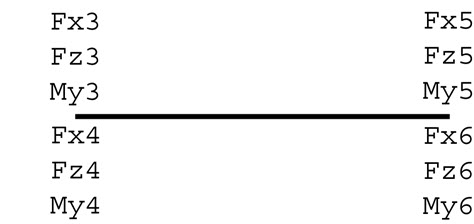Lateral Self Equilibrium Example
Consider the structure with two elevated floors shown in the following figure. Each level is 3m high and the structure is 10m wide.
Assume the following:
- a frame analysis has been performed on the building for this 100kN loading and the column forces are known
- a very simple distribution of forces (reasonable for beams much stiffer than columns)
The forces on the top level slab (including column reactions) are:
These forces are in equilibrium and are applied directly to the slab in a lateral SE loading. RAM Concept then calculates the correct forces in the slab, design strips and punching checks.
For the intermediate level there are more forces to consider (all of these are from the frame analysis). The forces that the columns apply to the slab are:
| Fx3 = 50kN | Fx4 = -50kN |
| Fx5 = 50kN | Fx6 = -50kN |
| Fz3 = 15kN | Fz4 = -45kN |
| Fz5 = -15kN | Fz6 = 45kN |
| My3 = 75kN-m | My4 = 75kN-m |
| My5 = 75kN-m | My6 = 75kN-m |
These forces are in equilibrium and are applied directly to the slab in a lateral SE loading.
Since the "3" and "4" forces occur at the same location, they can be added together and applied as a single load (same for "5" and "6").
RAM Concept then calculates the correct forces in the slab, design strips and punching checks.



